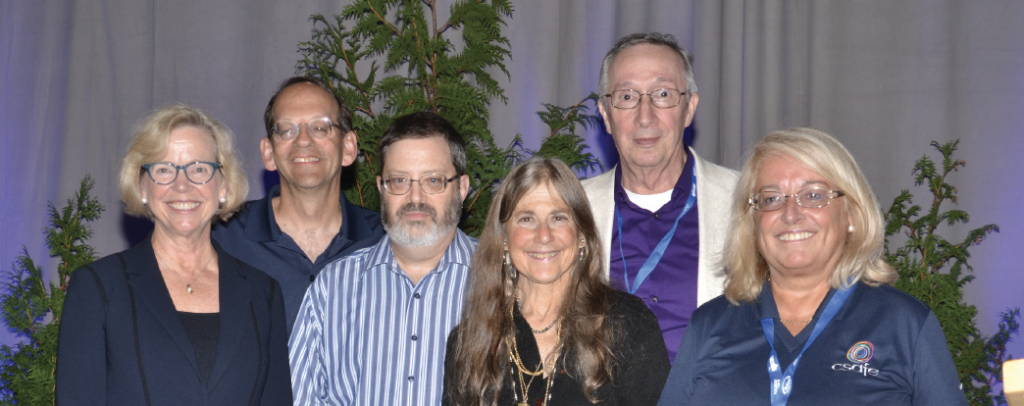2018 SPAIG Award Lauds Forensic Science Collaboration
Willis Jensen (WL Gore and Associates), Fanni Natanegara (Eli Lilly and Company) and Ying Ding (University of Pittsburgh) on behalf of the ASA SPAIG Committee
The 2018 SPAIG award, presented during the 2018 Joint Statistical Meetings in Vancouver, recognizes the collaboration between the Center for Statistics and Applications in Forensic Evidence (CSAFE) and the National Institute of Standards and Technology (NIST) for building a statistically sound and scientifically solid foundation for the analysis and interpretation of forensic evidence and contributing to the statistical training of forensic practitioners and legal professionals.
Established in 2002, the SPAIG award highlights outstanding partnerships among academe, industry, and government organizations and promotes new partnerships among these organizations.

From left to right, Lisa LaVange, ASA President, and some of the key contributors towards the 2018 SPAIG Award, including Hal Stern, William Guthrie, Karen Kafadar, William Eddy, and Alicia Carriquiry.
We asked Susan Ballou from NIST and Hal Stern from the University of California, Irvine, to answer the following questions about the collaboration:
Can you briefly describe how the collaboration started?
Susan: In 2014, NIST decided to establish a Forensic Science Center of Excellence to assist its work in statistics. NIST grasped that a thorough understanding and contextualizing of the uncertainty associated with every scientific measurement or analytical technique is a critical need in the forensic science community. To meet this critical need, NIST issued a federal funding opportunity announcement. The selected center of excellence proposal would enter into a cooperative agreement with NIST and receive approximately $4 million per year for five years.
Hal: The collaboration of the four universities started in response to a call for proposals to create a center of excellence in forensic statistics that would partner with NIST’s efforts in this area. The four principal investigators—Alicia Carriquiry of Iowa State, Steve Fienberg of Carnegie Mellon, Karen Kafadar of the University of Virginia, and me, all statisticians active in forensic science—proposed to create CSAFE to address the need for enhanced statistical methods to analyze pattern and digital evidence. The partnership with NIST grew stronger as we began to partner with NIST scientists and forensic practitioners.
What are the major benefits coming from the collaboration that would not have otherwise happened?
Susan: NIST has been working in this area, but the needed measurement infrastructure to support the vast array of forensic sciences is well-suited to a community-based approach. CSAFE has addressed both the utility of the probabilistic assessments in the forensic science arena and the advancement of useful methods for the presentation of probabilistic methods in the forensics community. From this, CSAFE realized one of the obstacles to the use of probabilistic information is the inability to adequately explain what it means to stakeholders (e.g., investigators, lawyers, judges, and juries) who must use the information to make decisions. This has complimented NIST’s strong measurement application allowing a two-pronged approach to support the integration of the research into the forensic science and legal communities.
Hal: The collaboration has benefited forensic science research in several ways. Data collected at NIST (e.g., on bullets and bullet cases) have been used to develop statistical methods. In addition, NIST collaborations with forensic practitioners have enabled us to incorporate practitioners in the research projects.
What have been the most rewarding aspects of the collaboration?
Susan: As a forensic scientist, I found the most rewarding aspect to be CSAFE’s realization of the level of difficulty of the task. This realization seemed to vindicate the forensic science profession for its hesitation to embrace statistics. Perhaps the reason why statistics and probabilistic statements have not been embraced by the forensic science community was due to the uncertainty of how to apply it. To address this, CSAFE took its time to learn from practitioners about case specifics, that cases vary, that quality of the evidence varies, that ground truth is rarely known, and that general application of statistics is not simple. At this point, CSAFE dug in and selected and adjusted projects to address the range of difficulty surrounding the task. I found CSAFE’s response invigorating.
Hal: An important part of the CSAFE-NIST collaboration has been the development of a number of training programs and seminars that try to teach forensic practitioners, lawyers, and judges about the role of statistics in the analysis of forensic evidence. Participating in these trainings, seminars, and workshops has been extremely rewarding. It is valuable to help others see how statistics can contribute to a better understanding of the uncertainty associated with the conclusions of a forensic analysis.
What advice would you give to individuals and organizations looking to be more collaborative?
Susan: The key to successful collaboration is maintaining an open mind. Do discuss your research and your goals, but keep an open mind to new pathways you may not have considered. Why expend unnecessary energy in areas the other team may have already explored? Listen to their thoughts and freely share your successes or non-successes (failures). In this context, the word failure does not exist. Failing to achieve the planned outcome may, in reality, be a success in demonstrating how not to attempt it. Successful implementation of a collaborative team is supported through mutual trust and respect.
Hal: Collaboration takes time, but is incredibly valuable in ensuring that novel statistical methods are addressing important problems. At the start, any collaboration requires a number of meetings to learn about the culture of the partnering disciplines and to learn how to speak a common language. Once this happens, the combined team can be more effective than what they could have been separately.

















